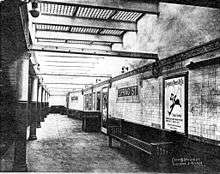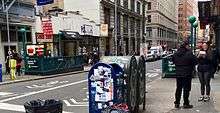Spring Street station (IRT Lexington Avenue Line)
Spring Street is a local station on the IRT Lexington Avenue Line of the New York City Subway. Located at the intersection of Lafayette Street and Spring Street in SoHo and Little Italy, Manhattan, it is served by 6 trains at all times, ⟨6⟩ trains during weekdays in the peak direction, and 4 trains during late night hours.
Spring Street | |||||||||||
|---|---|---|---|---|---|---|---|---|---|---|---|
Brooklyn bound platform | |||||||||||
| Station statistics | |||||||||||
| Address | Spring Street & Lafayette Street New York, NY 10012 | ||||||||||
| Borough | Manhattan | ||||||||||
| Locale | Little Italy, SoHo | ||||||||||
| Coordinates | 40°43′20″N 73°59′50″W | ||||||||||
| Division | A (IRT) | ||||||||||
| Line | IRT Lexington Avenue Line | ||||||||||
| Services | 4 6 | ||||||||||
| Structure | Underground | ||||||||||
| Platforms | 2 side platforms | ||||||||||
| Tracks | 4 | ||||||||||
| Other information | |||||||||||
| Opened | October 27, 1904[1] | ||||||||||
| Station code | 409[2] | ||||||||||
| Wireless service | |||||||||||
| Opposite-direction transfer available | No | ||||||||||
| Traffic | |||||||||||
| Passengers (2019) | 3,754,272[4] | ||||||||||
| Rank | 132 out of 424[4] | ||||||||||
| Station succession | |||||||||||
| Next north | Bleecker Street: 4 | ||||||||||
| Next south | Canal Street: 4 | ||||||||||
| |||||||||||
| |||||||||||
| |||||||||||
History
Spring Street was one of the 28 original stations of the first subway line in Manhattan, which opened on October 27, 1904.[5] At this time, Spring Street served local trains from the now-abandoned City Hall station to 145th Street at Broadway.
Station layout
| G | Street level | Entrances/exits |
| P Platform level |
Side platform | |
| Northbound local | ← ← | |
| Northbound express | ← | |
| Southbound express | | |
| Southbound local | | |
| Side platform | ||


Spring Street has two side platforms and four tracks, the center two of which are express tracks.[6] Both platforms have a slight curve which creates a gap between the train and the platform. Because this gap is not significant, gap fillers are not necessary.
Spring Street had a fifth center track at the time of its opening.[7][6] This track did not last long; it was reportedly disconnected and removed in 1906, only two years after the subway opened. Although its function has never been determined, the trackway is now used as the location of a mechanical room.[6]
The station retains the typical large and small IRT mosaics in the old (prior to platform lengthening) portion. The station has small "S" cartouches with two poppies from 1904, made by Atlantic Terra Cotta, and large mosaic tablets by Heins & LaFarge, also from 1904. Other small "S" and "Spring St" mosaics are newer.[6] The "S" cartouches are similar to the ones cast for Canal Street station.
Exits
Spring Street has four entrances, two to each platform. The northbound entrances are at either western corner of Lafayette and Spring Streets, while the southbound entrances are at either eastern corner of the same intersection.[8]
In popular culture
This station is featured in the 2008 film Cloverfield. The scene was not filmed there, however.[9] The station is featured in the season 3 episode, "Lo-Fi", in the television show Criminal Minds.
References
- "Our Subway Open: 150,000 Try It; Mayor McClellan Runs the First Official Train". The New York Times. October 28, 1904. p. 1. ISSN 0362-4331. Retrieved April 21, 2020.
- "Station Developers' Information". Metropolitan Transportation Authority. Retrieved June 13, 2017.
- "NYC Subway Wireless – Active Stations". Transit Wireless Wifi. Retrieved November 13, 2019.
- "Facts and Figures: Annual Subway Ridership 2014–2019". Metropolitan Transportation Authority. 2020. Retrieved May 26, 2020.
- Subway opening to-day with simple ceremony New York Times Retrieved August 30, 2008
- Spring Street (IRT East Side Line)NYCSubway Retrieved August 30, 2008
- "Postcard: "Five track subway construction, Spring and Elm Streets, New York"". www.nycsubway.org. Retrieved October 25, 2018.
-
- "MTA Neighborhood Maps: East Village" (PDF). mta.info. Metropolitan Transportation Authority. 2015. Retrieved August 19, 2015.
- "MTA Neighborhood Maps: SoHo / Tribeca" (PDF). Metropolitan Transportation Authority. 2015. Retrieved August 6, 2015.
- Cloverfield (2008)
Further reading
- Stookey, Lee (1994). Subway ceramics : a history and iconography of mosaic and bas relief signs and plaques in the New York City subway system. Brattleboro, Vt: L. Stookey. ISBN 978-0-9635486-1-0. OCLC 31901471.
External links
| Wikimedia Commons has media related to Spring Street (IRT Lexington Avenue Line). |
- nycsubway.org – IRT East Side Line: Spring Street
- Station Reporter — 4 train
- Station Reporter — 6 Train
- Forgotten NY — Original 28 – NYC's First 28 Subway Stations
- Spring Street uptown entrance from Google Maps Street View
- Spring Street downtown entrance from Google Maps Street View
- Platforms from Google Maps Street View



%26groups%3D_6730dd755715be2940d13b9bfeb3807609f73016.svg)